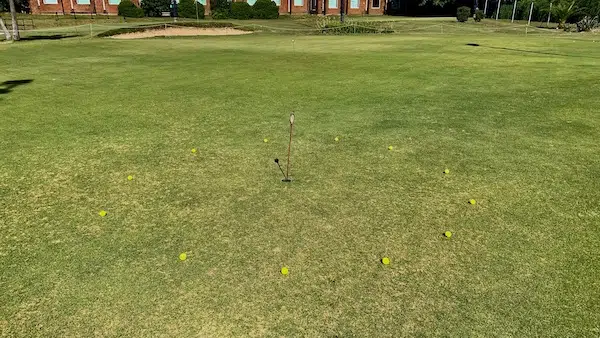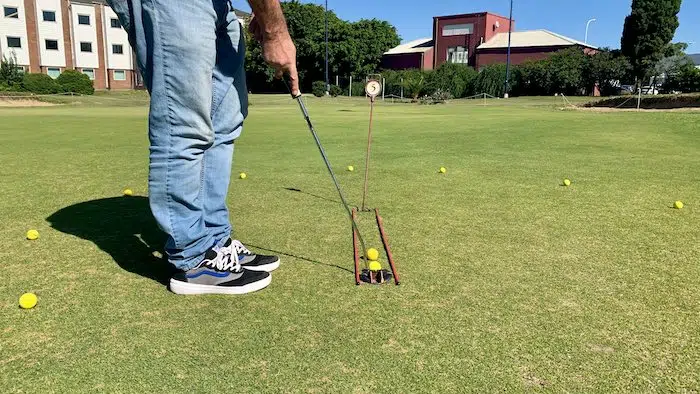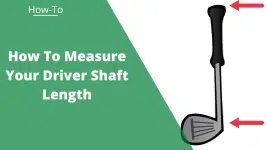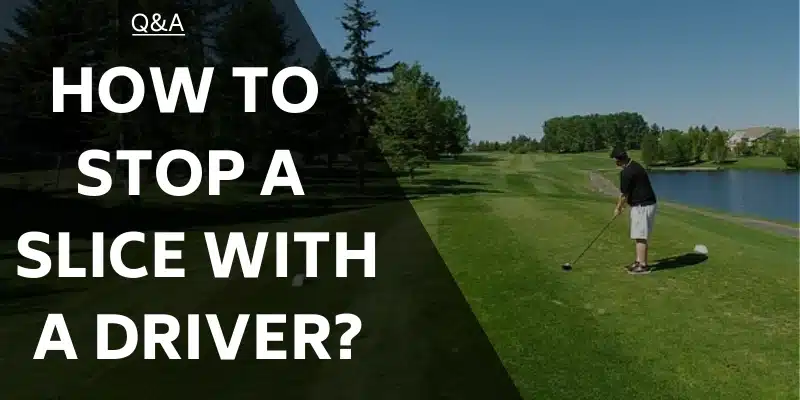My late father was a passionate believer that a solid short game wins you tournaments, a philosophy drilled into me since a young lad. I spent a large portion of my training hours on the green at my home club. In this post, I share the 12 best putting drills that helped me sink more putts.
The list includes a range of putting drills for pros and others that various coaches have taught me over the years. Some are elementary and designed for high handicappers, while others offer value to all skill levels.
Bookmark our guide to the best golf drills if you are struggling for training ideas. It is the perfect guide to follow up our good putting drills post below.
Best Putting Drills To Quickly Improve
1. Green Reading 101
Purpose Of The Drill
I call this drill green reading 101, but others refer to it as the straight line or follow the line. The objective is to discover the slope of the green between the ball and the target. Another factor is understanding the speed of the surface.
All you need for this drill are two tees, a few golf balls, and your putter.
Save our review of how to read greens for a more detailed rundown on understanding slopes and speed.
How To Do Green Reading 101?
Pick a target on the green, preferably a hole. If none are available, place a marker on your chosen zone.
Next, place two tees on the ground between 1 to 2 feet in front of the impact zone. Ensure the tees are wide enough for your ball to make it through but not wide enough to forgive wayward strokes.
Putt your ball through the tees and watch the line that takes you towards your target. If the ball misses to the left of the target, move the tees to the right, and try again. Once you find the line, stroke a minimum of 20 putts and master the speed on the dancefloor.
Here is a video of PGA Tour Pro Matt NeSmith working on the simple putting drill.
2. Gate Drill
Purpose Of The Drill
This ranks among the most simple putter alignment drills as it is effective and requires limited resources. The gate drill helps golfers square the putter face at contact to start their ball on the desired line.
Like the Green Reading drill, you only need your putter, golf balls, and two tees for this drill. If you prefer training aids for your golf putting practice, the EyeLine Putting Alignment Mirror is crafted for this drill.
How To Do The Gate Drill Putting Exercises?

Place a ball on the green, and insert two tees on either side of the strike zone to create a gate. The tees must be wide enough for your putter head to strike the ball, unobstructed, but close enough to punish an open or closed putter face.
If your putter face is square at contact, you may brush the tees gently, but still, strike the ball with a square putter face. On the other hand, if your putter is angled incorrectly, the putter face knocks the tees, and your contact with the ball is weakened.
Keep practicing this drill until you produce a minimum of 10 clean strikes, leading to improved accuracy. Here is a quick video of Daniel Berger showing how the gate-putting practice drill is done.
3. Clock Drill
Purpose Of The Drill
The clock drill is a constant among my putting exercises because it is fun, requires limited space on the green, and improves your short-range putts. You start at one point and cannot progress until you sink a putt from that position.
Besides your putter and golf balls, you only need a hole on the practice green. If you own a portable golf cup, you can add this to your home putting drills routine.
How To Do The Clock Drill?

Place 12 golf balls on the green equidistance from the cup, between 3 to 5 feet away. Start at 12 o’clock and only proceed to 1 o’clock once you have sunk the first putt. This trend continues until you drain the ball set up at 11 o’clock.
This is an excellent drill to drain up and downs or two putts from close range. Plus, you can take on your buddies and see who finishes first.
4. Coin On The Putter
Purpose Of The Drill
Placing a coin on your putter flange is a simple yet effective tempo putting drill. It helps you produce a fluid stroke. If your transition is messy, the coin falls in the opposite direction.
The aim is to help you transition smoothly from your backstroke to your forward stroke with optimal momentum for a clean strike.
How To Practice Putting The Coin Drill?
Place a coin on the top of your putter head or the flange, and prepare for a putt. As you commence your forward stroke, try to nudge the copper back and away from the target. A smooth transition should see the coin drop off the putter head and land smoothly on the green.
Phil Kenyon shares a clip of Martin Kaymer waxing the coin practice putting drills. You can see how effortlessly the former world number one strokes the golf ball.
Read more: How To Practice Golf At Home
5. Putt With A Wedge
Purpose Of The Drill
Who would’ve thought using a wedge is one of Tiger’s favorite golf putting drills? But it is, and I understand why because I followed his lead. This works wonders for determining the roll and speed of the dancefloor.
When you blade a putt, the golf ball rolls end over end, and you receive a better feel of how the green plays and the impact of the grass blades.
How To Putt With A Wedge?
Open the clubface of a sand or lob wedge and strike the golf ball from the equator upwards to keep it on the green and prompt forward roll. Watch the direction and speed at which your golf ball rolls to improve your alignment and distance control on future putts.
Read more: The Best Wedges on the Market
6. Barrier Behind The Cup
Purpose Of The Drill
Setting up a barrier behind the cup is one of the best putting drills for speed and distance control. It is designed to help golfers pass the cup on every shot to avoid leaving your long putts short and facing a testing second.
In addition, learning to roll past the cup improves your ability to drain longer putts because you generate sufficient speed and topspin. Habitually leaving your putts short will never place you in a position to make one putt birdies.
How To Setup Putting Practice Drills With A Barrier?
You can position a stick, golf club, or alignment rod 2 feet behind the cup and use it as a barrier. Start by putting 10 balls from 10 feet away and see how many balls you get between the cup and the alignment stick.
I like to keep score to enhance the challenge, and any balls that fall into the 2-foot zone are assigned pars. If I drain the putt, it counts as a birdie, but anything short of the hole or passed the 2-foot line is a bogey.
After 10 putts, I tally up my score for the 10-foot length before moving to 15 feet. Next, I move to 20 feet before finishing the set from 30 feet away. I find speed putting drills lead to greater distance control and a better dispersion rate on the greens.
7. Putt Reverse Handed
Purpose Of The Drill
The reverse-handed trick is among my best-putting speed drills. Whenever I struggle with distance control and feel, I channel a legendary golfer from my home province, Papwa Sewgolum. He operated with a reverse grip, which I learned that it limits wrist movement and increases control.
When I putt with this grip, I produce less rotation in my stroke and generally also produce a controlled strike with a clean roll. It takes power out of my stroke to prevent me from overcooking my putts and gives me a better feel for the speed of the green.
How To Practice Putting Drills Reverse Grip?
If you are a right-handed golfer, place your left hand on the bottom of your grip and your strong hand above. It should feel awkward, but do not feel alarmed. Pick a target and strike a golf ball using the reverse grip.
You may come up short of the cup on your first attempts, but keep adjusting the power of your putt until you have mastered speed control. Hit 10 to 20 putts with this grip and switch back to your regular setup to adjust the power of your stroke.
8. Train Track Drill
Purpose Of The Drill
The train track exercise is among my top putting drills for alignment because it makes it easy for golfers to identify their stroke path. Once you know your personal stroke, you can either work on straightening it or find the correct shaft and hosel for you.
The most effective way to execute this putting drill is to employ two rods, like the Callaway Alignment Stix.
How To Do The Train Track Alignment Drill?

You place two rods parallel to each other and a ball in the center of the track. Watch your putter as it moves away, and see if it deviates off the lane. If you take it straight back and forward, your stroke is straight, and you should operate with a face-balanced putter.
However, if you notice that your putter head arches during the stroke, you can either seek a toe-hang putter and accept your fate or work to straighten your stroke. I have generally operated with a slight arch stroke and decided to roll with it. Therefore, I watch my putter traveling slightly inside on the backstroke before returning to a square position on the downstroke.
9. Manilla Folder Drill
Purpose Of The Drill
My high school golf coach made me work on this best-putting practice drill for long-range efforts weekly. The greens at my home course slopped downhill on several holes, making them rapid and demanding precise lag putts.
This drill helps you judge the speed of long putts with an excess break. The folder is the position where your ball must stop rolling. Otherwise, it may have too much velocity and fly past the cup.
How To Practice Putting The Manilla Folder Drill?
Find a downhill slope on your putting green and place a folder or a marker that your ball can roll onto. Judge the distance and work to kill the roll of your ball when it reaches the folder. If you achieve this, your speed control is golden.
However, if it rolls over the folder, your ball has excess pace and will run past the cup. Also, if it fails to reach the folder, you face a challenging and fast downhill second putt.
10. Measuring Tape Drill
Purpose Of The Drill
The measuring tape drill is one of the best golf putting drills to judge the power of each stroke. Extending a measuring tape helps you visualize how far the putter head needs to travel on the backstroke from various distances.
I find it improves my dispersion rate on short and long putts, helping me make more birdies and avoid three putts.
How To Do The Measuring Tape Drill?
Extend a measuring tape and place it parallel to the impact zone. Set up golf balls 5 feet from the cup and watch how far you take the putter head back for each stroke. When you sink a putt, take notice of the length the clubhead traveled back. Repeat the process from other distances until you have all bases covered.
The most efficient way is to have a buddy spot for you and mark it. I suggest using different colors to highlight each distance. The next time you practice, take out the measuring tape for each length and work on nailing the backstroke on every occasion.
Read more: How To Improve Your Short Game
11. Distance Control
Purpose Of The Drill
My distance control drill combines with the measuring tape exercise to find the correct power for long-distance putts. With knowledge of the required backstroke length, work on mastering the strength and pace for putts from 20, 30, 40, and 50 feet away.
Phil Mickelson shares his experience preparing for Augusta and explains how to focus on the backstroke length variable. This drill empowers golfers to get closer on their first putts to position themselves to avoid a dreaded three-putt.
How To Do Distance Control?
Executing these effective putting drills for distance control is easy. Set up three golf balls each at 20, 30, 40, and 50 feet. Remember your optimal backstroke length from the measuring tape drill and drill to repeat it without the help of the measuring tape.
After putting the balls from 20 feet, move to the next marker until you complete putts from 50 feet away. Analyze your performance and repeat the cycle, starting back at 20 feet.
12. One-Handed Drill
Purpose Of The Drill
Like the reverse grip drill, the one-handed putting exercise is built to enhance tempo, stroke fluidity, and control. The lack of strength from both hands forces you to control the putter head and use the momentum from your stroke to preserve ball speed and topspin at contact.
You can use this drill to warm up before a round or to find your feel and stroke on off days.
How To Execute One Hand Practice Putting Drills?
Place your dominant hand behind your back and grip the putter with your weaker hand. Ensure the putter is controlled in your hand, and work on producing a pure stroke with a clean roll. I recommend setting up a maximum of 5 feet from the cup for this drill.
FAQ
Do Any Pros Look At The Hole When Putting?
Yes, Tony Finau, Jordan Spieth, and Louis Oosthuizen have looked at the hole when putting at some stage of their careers. Finau is the latest pro to look at the cup during the putting stroke.
Why Do I Struggle With Putting?
You struggle with putting because it is challenging to read the break and speed of the green while producing a fluid stroke and square putter face at contact. You can combine these factors to generate optimal distance control and accuracy on the green.
How Does Tiger Woods Practice Putting?
Tiger Woods uses techniques like one-handed putting and the gate drill in combination. In addition, Woods often blades a wedge on the putting green to identify the actual roll of the green.
Conclusion
There is a wealth of putting drills for golf, and there is no need to use them all. Some will work better for you than others. A diverse portfolio of exercises is the best way to master your putting stroke.
If it were up to me, I would suggest also working on the green reading 101 and gate drill, as they require limited resources and space. In my experience, the one-handed putter drill improves your feel and control, and the measuring tape optimizes power and distance control.
Finally, to eradicate three-putts from your game, I suggest practicing the clock drill to optimize your accuracy for close range. Overall, the list of our best golf putting drills will help beginners and low handicappers enjoy flat stick practice and leak fewer strokes on the green.
Matt has played golf since he was 4 years old and has written over 150 articles at GolfSpan since 2021. Matt specializes in product reviews using his postgraduate degree in Sports Marketing from Johan Cruyff Institute. Matt has a handicap index of 10.8 and currently plays weekly at Pilar Golf Course near his home in Buenos Aires, Argentina. He also loves his Callaway Odyssey Exo Rossie putter and likes a pepper steak pie with curry gravy at the turn. You can connect with him on LinkedIn.
- Best score: 70
- Favorite club: Callaway Odyssey Exo Rossie
- Favorite ball: Srixon Q-Star Tour
- Favorite food at the turn: Pepper steak pie with curry gravy









